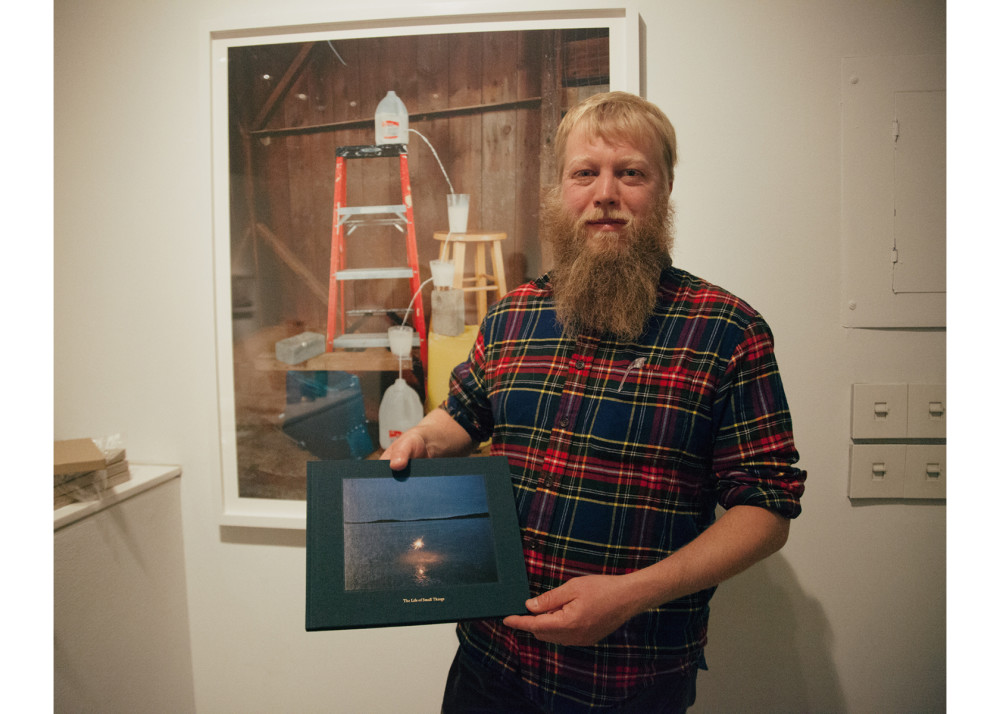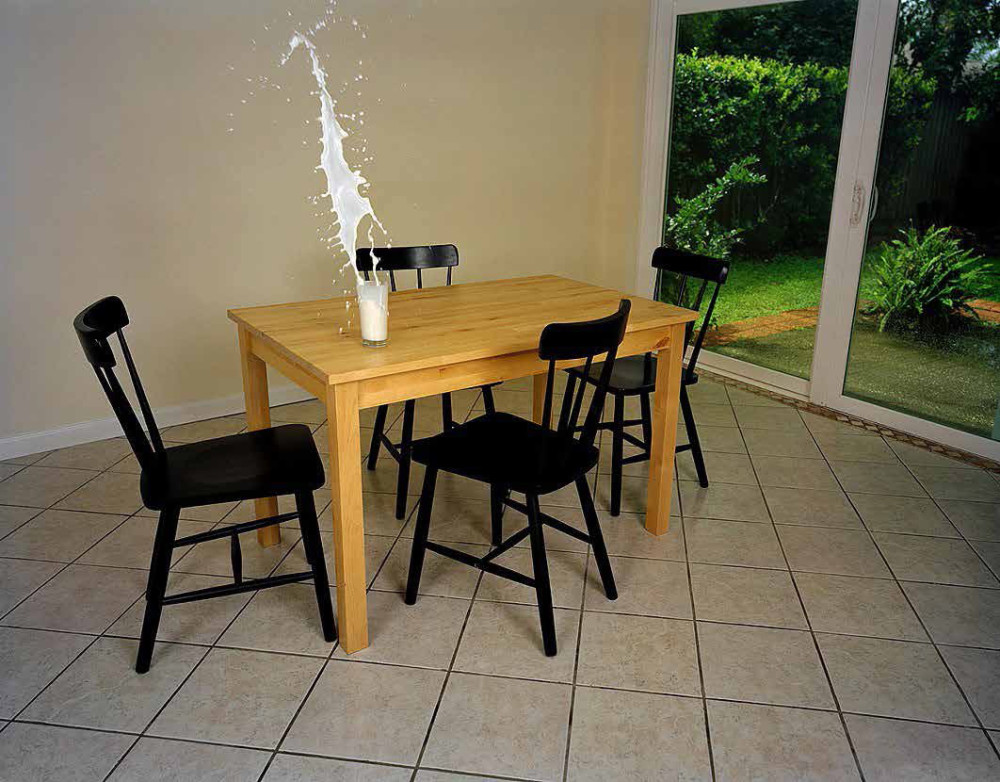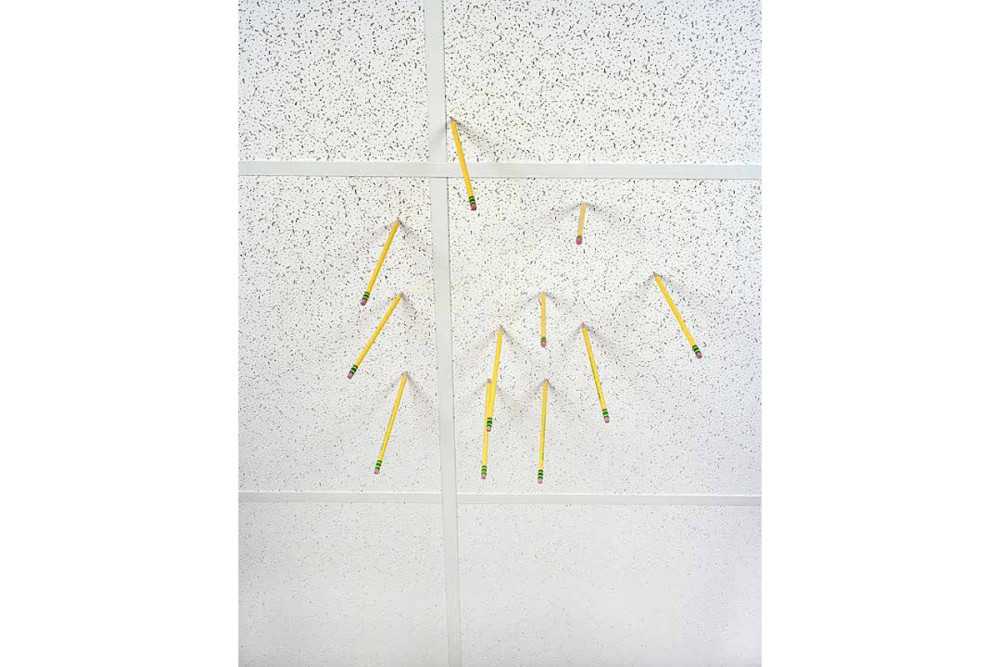Image above: © Adam Ekberg, Vacuum on a frozen lake, 2005 / Courtesy of the artist and Waltz Books.
 Image Above: © Ashley Comer, Portrait of Adam Ekberg
Image Above: © Ashley Comer, Portrait of Adam Ekberg
Remember that time when you were a kid, running around your backyard, chucking dirt into an oil canister somebody left behind? Maybe not. Maybe you were too busy trying to be normal, playing video games or whatever everyone else was doing at the time. That was, however, what Adam Ekberg spent his childhood days in a quiet Midwest home doing. Well, that and a few other things.
Refusing to let go of his childlike sense of novelty, Ekberg spends hours creating elaborate scenarios for his camera– from balloon filled rooms to exploding lawn chairs. He exploits the dullness in life by both literally and figuratively blowing it up. Isn’t that neat?
 Images above: © Adam Ekberg, From left- A Lawn Chair and a Blue Balloon, A Lawn Chair on Fire, A Lawn Chair Exploding, 2013 / Courtesy of the artist and Waltz Books.
Images above: © Adam Ekberg, From left- A Lawn Chair and a Blue Balloon, A Lawn Chair on Fire, A Lawn Chair Exploding, 2013 / Courtesy of the artist and Waltz Books.
Flipping through his new book, The Life of Small Things, one gets the sense that the photographs are documentations of an teenage boy’s science experiments. The purity of the moments that he explores and the technical happenings evoke a sense of youthfulness that is contagious.
Though I spent most of my youthful days enjoying the lazy pleasures of the Internet and Cable TV, the book makes me feel like young Sam from Wes Anderson’s Moonrise Kingdom, peculiar and inquisitive. His work awakens the explorer that lives in all of us, even if we find ourselves uncontrollably reaching for our phone the moment we shut Ekberg’s world back inside the book covers.
The book is an experience within itself, a surreal and magical journey into the artist’s mind. The trip blends reality with fantasy. We find ourselves wondering how the milk escaped its container to float around in mid-air. Or how the vacuum cleaner found it’s way outside in the snow. Our questions parallel the artist’s own. He creates space for us to question by asking questions himself.
 Image above: © Adam Ekberg, Occurrence #2, 2012 / Courtesy of the artist and Waltz Books.
Image above: © Adam Ekberg, Occurrence #2, 2012 / Courtesy of the artist and Waltz Books.
Ekberg is clearly too preoccupied with these questions to satisfy our curiosity with any answers. The photographs’ captions are blunt and dead-pan: ‘Transferring a gallon of milk from one container to another’ and ‘Extinguishing a small fire.’ We find ourselves sheepishly giggling through the frustration. This dry humor threads his work together, gives the sense of a mischievous youth. It’s just the kind of playful torture one can appreciate. Go ahead, Ekberg, tickle our fancy.
Initially, the animation of the inanimate objects distracts us, but soon, the giggles start to feel awkward. A dose of reality permeates the pages. Disco balls in empty bathrooms and blank woodsy scenes make us significantly aware of a lack of human activity. Bodies feature only as shadows or limbs. A desire for human interaction begins to accumulate within us. The isolated quality of the images becomes painful. At the start of the trip we felt hopeful, like a child, but now loneliness takes a jab at our spritely spirit.
The gloom brings back our darker childhood tales. We think of the hours we spent alone during school breaks, the days we were left behind after soccer practice, the hours we spent waiting for the arguments to end, the times our teenage friends pointed out that our clothes were horrid. We think of all the episodes consumed by loneliness that we’d forgotten.

Image above: © Adam Ekberg, Pencils in drop ceiling, 2005 / Courtesy of the artist and Waltz Books.
As I reminisce, the sadness passes. An image of a few pencils stuck in the ceiling reminds me of the resilience that fuels all children. I feel myself stripped of adult cynicism as I look back on the sweet tenderness of gloom. This stubborn, youthful spirit will exist within me till the day I die. The Life of Small Things is an excellent reminder of that.
The world Adam Ekberg projects is fragile yet strong. It is strung together by paradoxes and conflicting emotions. Easily malleable. Easily dismantled. And yet somehow by the end of the trip we feel tougher and determined. We feel revived. Like an emotional chemical peel: painful and unpleasant, yet necessary.



